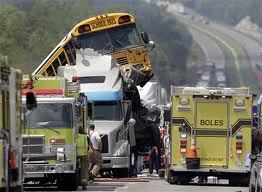Why Don’t Buses Have Seatbelts?
 I’ve wondered this question ever since grade school. Back then, we didn’t have to wear seatbelts, but I remember dutifully doing so and chastising my parents when they didn’t (probably something we learned in school). In Maryland, we weren’t required to wear seatbelts until July 1986, and that was only for front seat passengers.
I’ve wondered this question ever since grade school. Back then, we didn’t have to wear seatbelts, but I remember dutifully doing so and chastising my parents when they didn’t (probably something we learned in school). In Maryland, we weren’t required to wear seatbelts until July 1986, and that was only for front seat passengers.
Buses were always an anomaly. School buses and commuter buses alike had no seatbelts. Even worse, you are allowed to stand up on commuter buses. There’s a bit of a bias against commuter bus accident victims (probably stemming from the stories we all hear about people rushing onto a bus after an accident to try to get a piece of the insurance pie); but common sense suggests that bus passengers, not tethered to their seats, may very well sustain more injuries. If not, then what are seatbelts for?
We’ve been told by our safety leaders that school buses are safe because of the design of the seats–they are well anchored, padded and high enough so that injuries are rare. Essentially, our children are compartmentalized to prevent injury. These improvements were a result of a UCLA study from about 35 years ago. However, that study also recommended the following that have never been implemented:
- Lap belts
- Aisle side panels
Why are lap belts and side panels important? The main reason is obvious–not all collisions are rear-enders. If a truck comes out of a side street and t-bones my child’s school bus, my child is going to move to the side, possibly fall into the aisle and onto the bus floor. If the bus rolls over on its side, my child will be propelled into the air. That’s not safety.
 Maryland Car Accident Lawyer Blog
Maryland Car Accident Lawyer Blog

